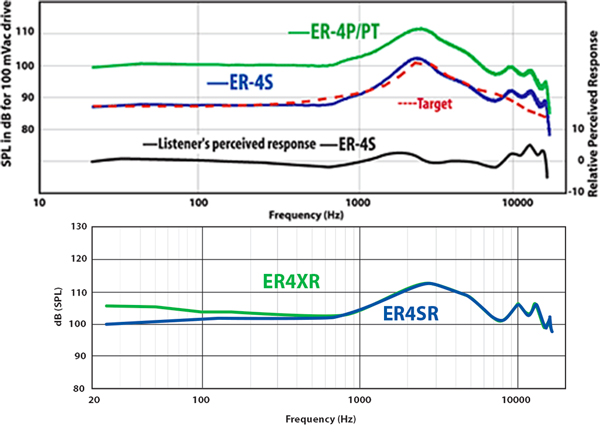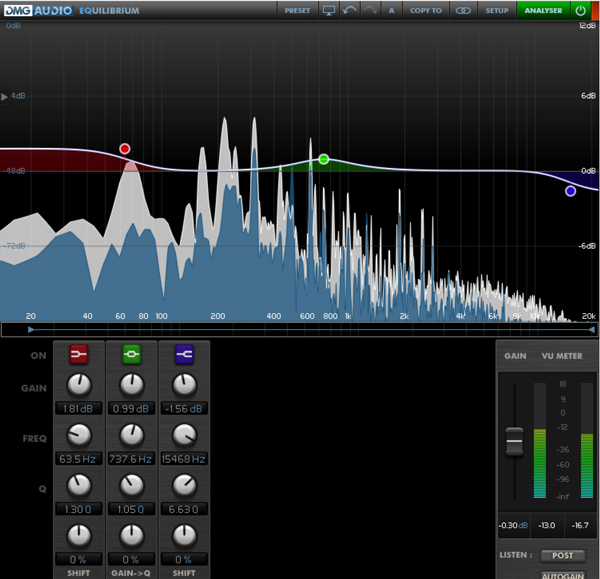| Columns Retired Columns & Blogs |
25 Years of Making a Good Thing Better: The Etymotic ER4sr and ER4XR Page 2

Etymotic Tuning
As I said at the very top, Etymotic is a hearing health company and come to the design of IEMs from a particular angle. One might say from the perspective of a hearing aid maker—they don't make the hearing aids, but they do make equipment hearing aid manufacturers use in their development work. Etymotic's idea of accurate, from my understanding, is to be able to perfectly reproduce at the ear drum what you would hear if you were listening to a person three feet away outdoors. And I firmly believe they're able to achieve that.
The problem is that's not the way speakers sound in a room. Floyde Toole has pointed out that speakers that are flat in an anechoic chamber will have a bass boost and gentle roll-off in a room. As a result, Harman's research leads them to believe that headphones should have should have a similar bass boost and slight warm tilt to sound correct. Essentially, Etymotic's target response, which is correct for normal sounds in an open space, should have the bass boost and gentle warm tilt added to it to sound like speakers in a room.
Of course, the science isn't settled on this, there is no universal agreement among enthusiasts, and Etymotic is entitled to their perspective—they are eminently qualified to hold an authoritative position on what they consider accurate. But it interesting to note that over the evolution of the product there's been an ongoing trend to make these headphones have more bass.

The plot above shows the raw eardrum response for the various ER4 products. Not shown is the original ER4B (the B stands for binaural) which is similar to the ER4S but starting at about 1200Hz tips upward and is about 5dB higher than the ER4S curve at 10kHz.
The subsequent ER4P is similar to the ER4S, but above 1200Hz tilts downwards to be about 8dB down at 10kHz. This was done by removing a resistor from the cable primarily to make them more easily driven by portable players, but the warming effect was welcome by many users.
Here's what Dave Friesema, product manager for Etymotic consumer IEMs, had to say in this Head-Fi.org post:
The first ER4 we ever released was the ER4B and is most accurate to the raw frequency response of the human ear. The ER4S (and the adjusted target curve) came later in response to significant market pressure from our users who liked the ER4B but simply felt it was too bright. The ER4P then came to pass because the sensitivity of the ER4S was too low for most portable users (back then portable media players and CD players had lower output levels). At the time, we had to compromise on the high frequencies with the ER4P because we ultimately needed enough sensitivity that people could use them.
In this latest iteration of the ER4, Etymotic is offering two tunings: The ER4SR (for studio reference) has what Etymotic considers an accurate response and is very much like the preceding ER4S. But Etymotic has long known that many people prefer a stronger bass, so they've now introduced the ER4XR (extended response) that has an emphasized bass response.
For me, having over 20 years of close experience interacting with Etymotic and the ER4 product evolution, I find it an interesting example of corporate learning at work. On the one hand, Etymotic has very strong reasons to believe they have a grip on what "accurate" means, on the other, they have 20 years of experience with customer feedback about the desire for more bass. Adding bass willy-nilly is simply not something this audiometry company would do; but having strong feedback that customers want more bass can't be denied either. Making the corporate decision to deviate from technically accurate to cater to user preference is actually a pretty brave move from their point of view. I applaud this development!
Sound Quality
The ER4 series IEMs have long been praised by headphone enthusiasts for their immaculate treble response...and deservedly so. The engineers at Etymotic are incredibly familiar with what goes on in the human ear canal and their expertise is obvious when listening to the ER4SR/XR.
To my ears the tonality of the treble is spot on. But more importantly, I hear no artificialness getting in the way of the natural sound of cymbals at all. No extra shimmer, no annoying harshness, all the overtones seem properly in proportion. Very, very nice and smooth but articulate response.
On both models I do hear a slightly relaxed presence region, but the degree is small, and the integrity of vocal overtones is very well maintained.
Bass response on both models is quite good, but is slightly less impactive and punchy than multi-BA IEMs that have dedicated low frequency drivers. I also hear a very modest amount of bass distortion. None of this, however, is significant enough do draw my attention to it.
For me, the bass level on the ER4SR simply isn't enough. Frankly, even the ER4XR doesn't have enough bass for me, but it's much better. I believe quite strongly that bass response on headphone should have about a 5dB bass boost below about 150Hz. Measurements show the ER4XR to have a very broad bass bump centered around 50Hz approximately, which falls to the bassline at about 400Hz. So while the bass boost isn't strong enough, it also bleeds into the mids some. I do hear this as slightly thickening the low midrange response. Had Etymotic turned the bass up even more with this particular driver response, I think it would have muddied up the lower mids too much. I think Etymotic chose judiciously.
Here's my EQ setting for tonal correction to the ER4XR.

The problem is that I felt adding EQ, while improving overall tonality, detracted from the overall integrity of the presentation. One of the very strong suits of these headphones is a very coherent presentation—there's a sense of completeness and "the music as a whole" that these headphones do very well. Whether it's due to the single driver and lack of crossovers I don't know, but I really enjoy the way these earphones portray a complete picture that can be appreciated as a whole. Adding EQ tends to deconstruct that integrity of sound to my ears.
I didn't notice this initially, but after reading Marv's measurement thread, it was brought out that some feel the SR is cleaner sounding than the XR, which is backed up by both his and my measurements. I think I did perceive the XR as ever so slightly harder sounding at high levels and loud passages, but in normal listening I can't say I heard any differences clearly. This may definitely be a case of different people having different sensitivities, but I felt the distortion (which only broke 1% at 100dBspl) was a completely ignorable problem, while the lack of bass on the SR stuck out like a sore thumb for me.
Other than a slightly soft bass response, the sense of dynamics both big and small is beautifully controlled. Again, maybe not quite as good as multi-driver IEMs where each driver is only burdened by a part of the audio spectrum, but having both good dynamics and a coherent presentation is very satisfying indeed.
The only place I find these headphones lacking is that they tend to produce a somewhat narrow and substantially shallow image. When going back and forth between these and my JH13FP (which is a much more expensive IEM) I tend to hear the Etymotics as having an almost cardboard cut-out nature. I don't want you to read that as too dramatic, I certainly don't hear it strongly when doing long listening to the ER4XR alone. But in direct comparison it seems obvious to me. The ER4SR/XR just doesn't image deep at all for me.
Bottom line here is that I find the ER4XR a very well balanced but still slightly cool headphone, and I find the ER4SR too cool by not having enough bass. I would recommend the ER4XR to both enthusiast and audio professionals.
Summary
The recent refresh of the Etymotic ER4 is a very welcome upgrade to a legendary IEM. The anodized aluminum earphone body will improve durability significantly. The cable is excellent with a nice dead, low-tangle feel to the main body of the cable, and the thin twisted pair of the leads to the earpieces lay easily and comfortably over the top of the ears. Ample tips, good accessories, and a somewhat too large zippered case are included.
I definitely prefer the extra bass of the ER4XR over the flatter sound of the ER4SR, and would recommend the XR as the preferred headphone for both audio pros and enthusiasts alike. Overall tonality, dynamics, and coherence of the ER4XR is very good; treble performance is simply outstanding with no trace of harshness or artificiality. Audio image is somewhat narrow and quite shallow. Depth of image is this earphone's weakest point; in all other ways it's performance is very good to excellent.
 The Etymotic ER4XR will easily make the "Wall of Fame" pushing the preceding ER4PT off. This is and outstanding headphone at this price, built to last for many years to come. The Etymotic ER4XR will easily make the "Wall of Fame" pushing the preceding ER4PT off. This is and outstanding headphone at this price, built to last for many years to come.
|
 The ER4SR doesn't have enough bass for me, but some will find it a slightly cleaner sounding headphone and may prefer it on that basis. The ER4SR doesn't have enough bass for me, but some will find it a slightly cleaner sounding headphone and may prefer it on that basis.
Enjoy!
|
Click here to view on YouTube.
Resources
Etymotic home page and ER4SR/XR product page.
Head-Fi reviews for ER4SR and ER4XR, and really long thread here.
Here's a link to the post in the above thread where Dave Friesema of Etymotic starts talking about the new ER4.
It takes a page or two to get rolling, but here's the superbestaudiofriends.org thread, and Marv does thorough measurements here.
- Log in or register to post comments




































